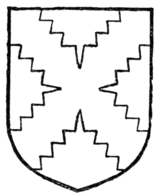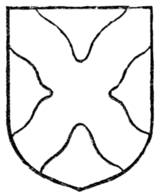found that it is couped conformably to the outline of the shield; but if the couped saltire be one of a number or a subsidiary charge it will be found couped by horizontal lines, or by lines at right angles. The saltire has not developed into so many varieties of form as the cross, and (e.g.) a saltire botonny is assumed to be a cross botonny placed saltireways, but a saltire parted and fretty is to be met with (Fig. 193).
THE CHIEF
The chief (Fig. 194), which is a broad band across the top of the shield containing (theoretically, but not in fact) the uppermost third of the area of the field, is a very favourite ordinary. It is of course subject to the variations of the usual partition lines (Figs. 195-203). It is usually drawn to contain about one-fifth of the area of the field, though in cases where it is used for a landscape augmentation it will usually be found of a rather greater area.
The chief especially lent itself to the purposes of honourable augmentation, and is constantly found so employed. As such it will be referred to in the chapter upon augmentations, but a chief of this character may perhaps be here referred to with advantage, as this will






